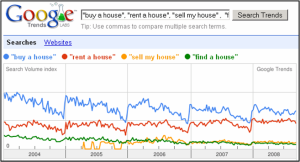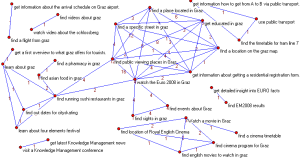The US housing crisis has been frequently reported as one major cause for the current financial turmoil. I was wondering whether indicators for the housing crisis can be found in Google’s Search Query Logs.
To look into this, I compared the search volume for the following explicit intentional queries: “buy a house”, “rent a house”, “sell my house” and “find a house”. The results are interesting, yet hardly surprising.
” Buy a house” undergoes seasonal fluctuations, with peaks at the end/beginning of every year. Overall though, there seems to be a downward trend. At the same time, “sell my house” and “rent a house” are on the rise. “Find a house” is relatively stable, but slowly declining as well. Although subtle, the housing crisis can be identified in the data.
Google Trends seems to provide some interesting data (such as the one above), yet I miss some features and several questions remain unanswered. I’d love to see a mashup with Google Maps, where I can not only plot the queries over time, but map them on different regions of the US. Questions that I would like to have answered include: 1) What is the absolute search volume of queries? Google does not give a way the absolute number of queries per of interest. 2) Does Google account for rising query volume? I assume that the total number of queries issued in 2004 is significantly lower than the total number of queries issued in 2007. So does a decline in, for example, the blue curve refer to an absolute decline in numbers, or to a relative decline that factors in overall query volume increase? 3) “Sell my house” does not have any data before 2005 – what does this mean exactly? It seems odd that people on the web did not (or hardly) use the term “sell my house” before 2005 on Google.
Yet, the kind of analysis provided by Google hints towards potential applications of taking an explicit goal-oriented stance on the web.
Update (Oct 7 2008): It seems that Google Insights for Search covers many of the issues identified above. See the example here (you must be logged into your Google Account to see the numbers).


